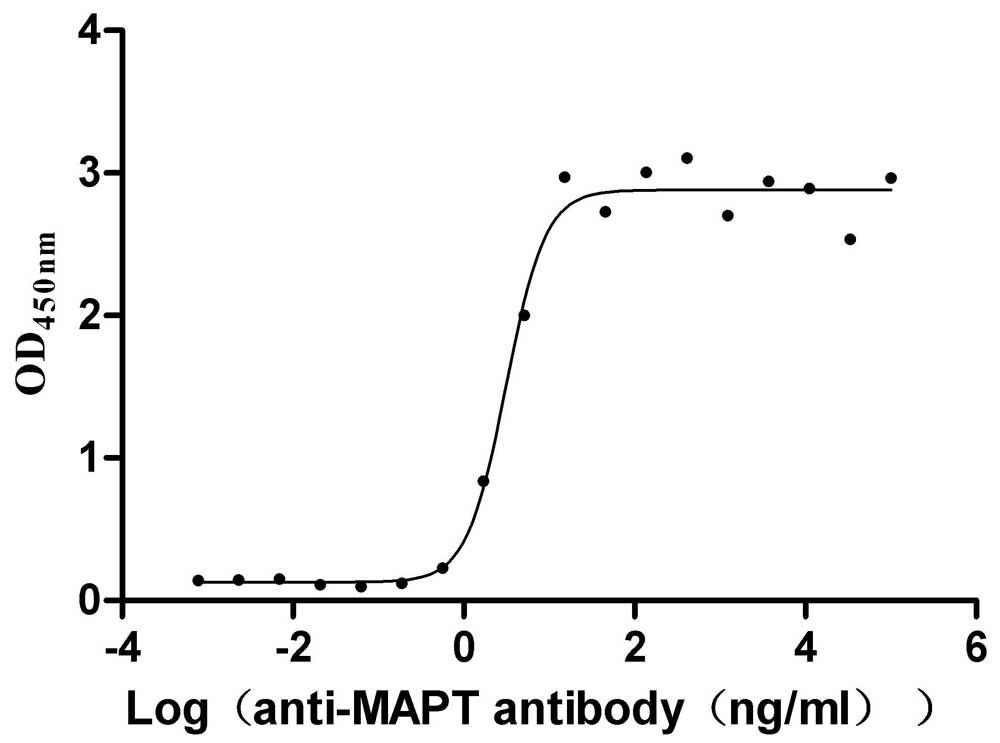Recombinant Mouse Proline-rich membrane anchor 1 (Prima1), partial
-
中文名稱:小鼠Prima1重組蛋白
-
貨號(hào):CSB-YP802269MO
-
規(guī)格:
-
來源:Yeast
-
其他:
-
中文名稱:小鼠Prima1重組蛋白
-
貨號(hào):CSB-EP802269MO
-
規(guī)格:
-
來源:E.coli
-
其他:
-
中文名稱:小鼠Prima1重組蛋白
-
貨號(hào):CSB-EP802269MO-B
-
規(guī)格:
-
來源:E.coli
-
共軛:Avi-tag Biotinylated
E. coli biotin ligase (BirA) is highly specific in covalently attaching biotin to the 15 amino acid AviTag peptide. This recombinant protein was biotinylated in vivo by AviTag-BirA technology, which method is BriA catalyzes amide linkage between the biotin and the specific lysine of the AviTag.
-
其他:
-
中文名稱:小鼠Prima1重組蛋白
-
貨號(hào):CSB-BP802269MO
-
規(guī)格:
-
來源:Baculovirus
-
其他:
-
中文名稱:小鼠Prima1重組蛋白
-
貨號(hào):CSB-MP802269MO
-
規(guī)格:
-
來源:Mammalian cell
-
其他:
產(chǎn)品詳情
-
純度:>85% (SDS-PAGE)
-
基因名:Prima1
-
Uniprot No.:
-
別名:Prima1Proline-rich membrane anchor 1; PRiMA
-
種屬:Mus musculus (Mouse)
-
蛋白長(zhǎng)度:Partial
-
蛋白標(biāo)簽:Tag?type?will?be?determined?during?the?manufacturing?process.
The tag type will be determined during production process. If you have specified tag type, please tell us and we will develop the specified tag preferentially. -
產(chǎn)品提供形式:Lyophilized powder
Note: We will preferentially ship the format that we have in stock, however, if you have any special requirement for the format, please remark your requirement when placing the order, we will prepare according to your demand. -
復(fù)溶:We recommend that this vial be briefly centrifuged prior to opening to bring the contents to the bottom. Please reconstitute protein in deionized sterile water to a concentration of 0.1-1.0 mg/mL.We recommend to add 5-50% of glycerol (final concentration) and aliquot for long-term storage at -20℃/-80℃. Our default final concentration of glycerol is 50%. Customers could use it as reference.
-
儲(chǔ)存條件:Store at -20°C/-80°C upon receipt, aliquoting is necessary for mutiple use. Avoid repeated freeze-thaw cycles.
-
保質(zhì)期:The shelf life is related to many factors, storage state, buffer ingredients, storage temperature and the stability of the protein itself.
Generally, the shelf life of liquid form is 6 months at -20°C/-80°C. The shelf life of lyophilized form is 12 months at -20°C/-80°C. -
貨期:Delivery time may differ from different purchasing way or location, please kindly consult your local distributors for specific delivery time.Note: All of our proteins are default shipped with normal blue ice packs, if you request to ship with dry ice, please communicate with us in advance and extra fees will be charged.
-
注意事項(xiàng):Repeated freezing and thawing is not recommended. Store working aliquots at 4°C for up to one week.
-
Datasheet :Please contact us to get it.
靶點(diǎn)詳情
-
功能:Required to anchor acetylcholinesterase (ACHE) to the basal lamina of the neuromuscular junction and to the membrane of neuronal synapses in brain. Also able to organize ACHE into tetramers.
-
基因功能參考文獻(xiàn):
- It interacts with PS1 and undergoes proteolytic processing. PMID: 24612677
- Elevated expression of muscarinic receptors is responsible for physiological adaptation of PRiMA-deficient developing mice. PMID: 23861875
- the relative content of AChE, BuChE and PRiMA mRNAs were compared in normal and Lama2dy muscle and sciatic nerve PMID: 22906800
- The N-linked glycosylation of AChE(T) plays a major role for acquisition of AChE full enzymatic activity but does not affect its oligomerization. PMID: 21795704
- Data show that along the nerve terminus the vast majority of acetylcholinesterase is anchored by collagen Q that is only produced by the muscle, whereas very minor amounts of AChE are anchored by PRiMA that is produced by motoneurons. PMID: 20883790
- PRiMA expression is predominantly to the cholinergic system and that anchoring of cholinesterases to cell membranes by PRiMA represents a limiting factor for production of the AChE tailed splice variant (AChET)-PRiMA complex. PMID: 14622217
- A peptidic motif of PRiMA1 is defined which is nearly as efficient as the complete extracellular domain of PRiMA for recruitment of acetylcholinesterase subunits into secreted heteromeric complexes. PMID: 17158452
- expression of PRiMA, as well as PRiMA-associated G(4) AChE, in muscle is suppressed by muscle regulatory factors, muscular activity, and nerve-derived trophic factors PMID: 17324938
- Acetylcholinesterase associates differently with its anchoring proteins ColQ and PRiMA PMID: 18511416
- PRIMA-1MET targets mouse tumors carrying mutant p53 PMID: 18791272
- Proline-rich membrane anchor protein is necessary to target and/or to stabilize nascent acetylcholinesterase in neurons. PMID: 19357277
顯示更多
收起更多
-
亞細(xì)胞定位:Cell membrane; Single-pass type I membrane protein. Cell junction. Cell junction, synapse. Note=In the brain, PRIMA linked to ACHE is found in membrane rafts.
-
組織特異性:Predominantly expressed in the central nervous system, including in the brain. Also expressed in muscle, heart and kidney. Isoform 1 may be predominant in the cortex and striatum, while isoform 2 is more abundant in the cerebellum.
-
數(shù)據(jù)庫鏈接:
Most popular with customers
-
Recombinant Mouse Desmoglein-3 (Dsg3), partial (Active)
Express system: Mammalian cell
Species: Mus musculus (Mouse)
-
Recombinant Human Poliovirus receptor (PVR) (I340M), partial (Active)
Express system: Mammalian cell
Species: Homo sapiens (Human)
-
Recombinant Human E3 ubiquitin-protein ligase ZNRF3 (ZNRF3), partial (Active)
Express system: Mammalian cell
Species: Homo sapiens (Human)
-
Recombinant Human Prolactin receptor (PRLR), partial (Active)
Express system: Mammalian cell
Species: Homo sapiens (Human)
-
Recombinant Macaca mulatta Microtubule-associated protein tau (MAPT) (Active)
Express system: Mammalian cell
Species: Macaca mulatta (Rhesus macaque)
-
Recombinant Human C-X-C chemokine receptor type 4 (CXCR4)-VLPs (Active)
Express system: Mammalian cell
Species: Homo sapiens (Human)
-
Recombinant Macaca mulatta Semaphorin-4D isoform 1 (SEMA4D), partial (Active)
Express system: Mammalian cell
Species: Macaca mulatta (Rhesus macaque)
-
Recombinant Human Cannabinoid receptor 1 (CNR1)-VLPs (Active)
Express system: Mammalian cell
Species: Homo sapiens (Human)



-AC1.jpg)



-AC1.jpg)










